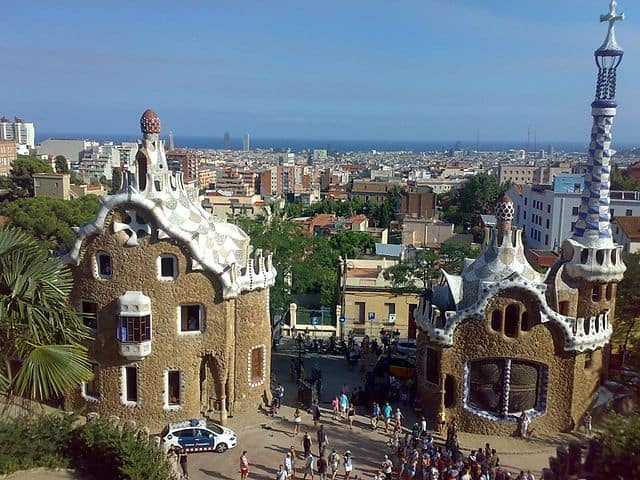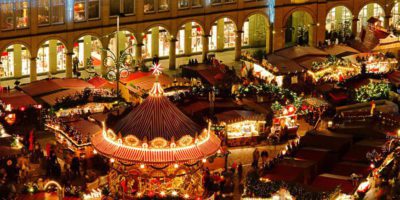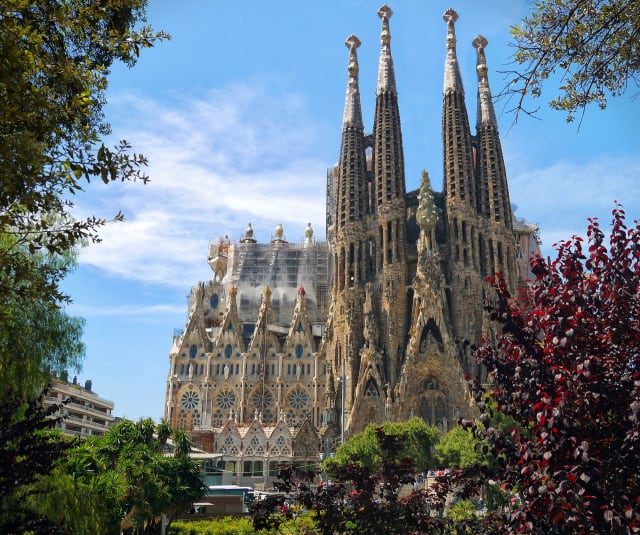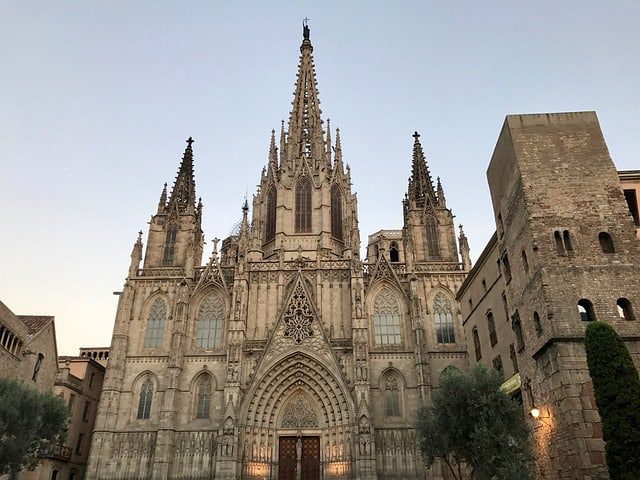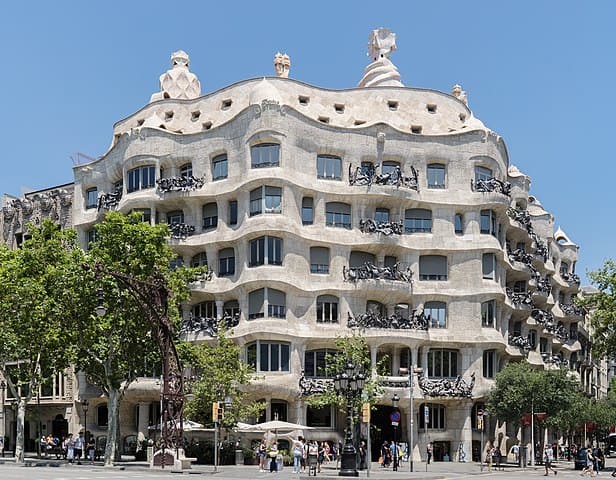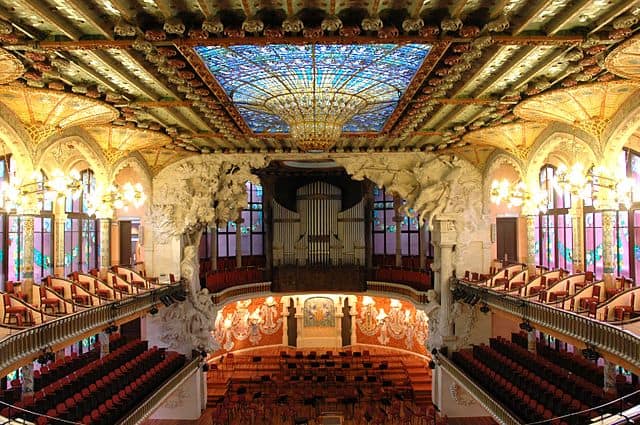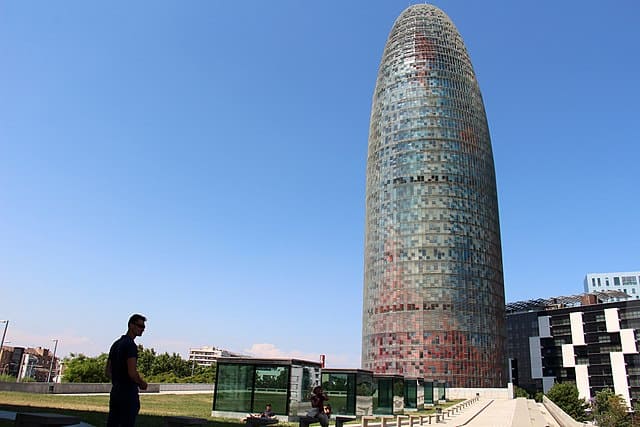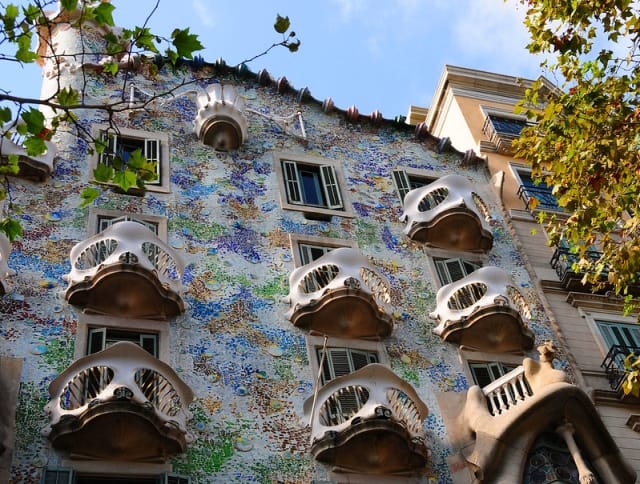A quick guide to Barcelona’s architecture
Barcelona is known to many as a hotspot tourist destination for it’s beaches, nightlife and historical monuments. The city is also well known for it’s architecture!
There are several different architectural styles in Barcelona, all of which are worth checking out! Antoni Gaudí is probably the most famous architect to come out of Barcelona, but there is so much more to see in addition to his work.
There are so many interesting architectural gems scattered around Barcelona, that it was hard for me to choose just a few to map our for you here. That’s why I’m calling this a “quick guide,” as I could honestly write articles about each of the locations I mention. Another project for another day!
Want to learn more? You’ve come to the right place! Keep reading for my quick guide to Barcelona’s architecture.
Sagrada Familia
Any good list of architectural feats in Barcelona must include the Sagrada Familia, the massive unfinished basilica by Gaudí. Unfinished, you say? Yes! Construction on the basilica began in 1882, and it is still incomplete to this day.
We can thank a man named Josep Maria Bocabella for the conception of the Sagrada Familia. The bookseller was inspired by a basilica in Loreto, Italy, which Bocabella saw in 1872. If you do a quick Google search, you’ll see that the Sagrada Familia does not look at all like the Loreto basilica, and that is thanks to Gaudí, who took over the project in 1883.
The first time that I saw the Sagrada Familia, I immediately thought of those sandcastles that are made by dripping layers of wet sand on top of one another. Do you know what I mean? There is so much to observe and admire here, that you’ll want to spend at least a few hours discovering Gaudí’s masterpiece.
There are 3 large façades which depict the Nativity, the Passion and the Glory. The interior is also something to be beheld: the vaulted ceilings, stained glass windows and an impressive organ are waiting to be discovered.
When Gaudí was questioned over the long construction period, he cooly replied, “My client is not in a hurry.” Well said!
Practical information:
Entry fee: 17 euros
Opening hours: Open every day 9am-7pm
Address: Carrer de Mallorca, 401, 08013 Barcelona, Spain
Website
Cathedral of Barcelona
The Cathedral of Barcelona is located in the Gothic Quarter of the city. Here, you’ll find the remains of a Medieval Barcelona, and the architecture that was prominent at that time.
Construction on the cathedral began in 1298 on the site of a former Roman temple. The cathedral was built in 3 different stages over a 150 year period. Slow and steady wins the race, as they say! The cathedral continues to be cleaned, restored and maintained today.
The Cathedral de Barcelona boasts a Gothic architectural design and also features a small side chapel called the Chapel of the Holy Sacrament and of the Holy Christ of Lepanto.
The interior is just as beautiful as the exterior, so don’t forget to head inside after you’ve finished admiring the outside.
Practical information:
Entry fee: 7 euros
Opening hours: Monday-Friday 12:30pm-7:45pm, Saturday 12:30pm-5:30pm. Sunday 2pm-5:30pm
Address: Pla de la Seu, s/n, 08002 Barcelona, Spain
Website
Frank Gehry’s Fish
Is it just me, or does it seem like Frank Gehry has designed buildings and sculptures all over the world?! Barcelona is no exception, where you’ll find Gehry’s massive sculpture of a fish, which he made in honor of the 1992 Barcelona Olympics.
This golden fish sculpture is located on the Barcelona coastline. Today, in addition to adding some beauty to the city, it is also used as a canopy which connects the luxury hotel, Hotel Arts, to the seaside.
Practical information:
Entry fee: Free
Opening hours: The Fish is located outside, so you can visit it anytime.
Address: Carrer de Ramon Trias Fargas, 2, 08005 Barcelona, Spain
Casa Milà
Another Gaudí creation, coming right up! Casa Milà was the Spanish architect’s last home, and was built between 1906-1912. Locals call the Casa Milà La Pedrera, which means the stone quarry in Spanish. Why? Because the façade of the building looks a lot like an open quarry.
The Casa Milà features many innovations designed by Gaudí himself. Cutting edge technologies like a free-plan floor, a self-supporting stone façade and an underground garage are just a few.
I find this building absolutely spectacular! The exterior is really a site to be seen, with it’s wrought iron balconies and curved edges. The interior is not to be missed either, with it’s patio, painted ceilings and modernist features throughout. The furniture is also gorgeous, and embodies an obvious Art Nouveau style.
Practical information:
Entry fee: 22-34 euros
Opening hours: Open every day 9am-6:30pm, 7pm-9pm
Address: Passeig de Gràcia, 92, 08008 Barcelona, Spain
Website
Palau de la Música Catalana
Built and designed by modernist architect Lluís Domènech i Montaner as a home for the Orfeó Català (Barcelona’a choir), the Palau de la Música Catalana was constructed between 1905-1908. This concert venue is the only one of it’s kind to be granted World Heritage Site status by UNESCO.
The building boasts a unique Art Nouveau design, filled with curved edges, bright colors and mosaic tiles throughout. It is located in the La Ribera neighborhood of Barcelona, and it’s brilliant colors stand out in comparison to the surrounding buildings.
The Concert Hall is the most famous room in the venue, where you’ll find glass ceilings and beautiful stained glass windows. There is also the Petit Palau, which is a much smaller room that was built in 2004. The new designs blend seamlessly with the old, and I definitely recommend you take a guided tour of the premises!
P.S…don’t miss our free guided tour of Barcelona’s Old Town and we’ll show you exactly where to find this beauty.
Practical information:
Entry fee: 20-22 euros
Opening hours: You must book a guided tour in order to enter the Palau de la Música Catalana if you aren’t going there for a concert. Click here for more details.
Address: C/ Palau de la Música, 4-6, 08003 Barcelona, Spain
Website
Santa Caterina Market
The Santa Caterina Market is located on the grounds of the former Santa Caterina Convent, and was inaugurated in 1848, and was originally designed by Spanish architects Josep Mas i Vila and Josep Buxareu.
By the early 2000s, the market was in dire need of repair. The architectural team of husband and wife Enric Miralles and Benedetta Tagliabue (also known as EMBT) stepped in to save the day! The team added on the colorful waved roof which features a mosaic design, and was thought up by artist Toni Comella.
The market still operates today, so head there if you want to stock up on fresh produce, meats, fish and other food products!
Practical information:
Entry fee: Free
Opening hours: Monday-Saturday from 7:30am. The market closes at 3:30pm on Monday, Wednesday and Saturday, and at 8:30pm on Tuesday, Thursday and Friday.
Address: Av. de Francesc Cambó, 16, 08003 Barcelona, Spain
Torre Glòries
Formally known as the Torre Agbar, the Torre Glòries is a 38-story skyscraper is located in the technological district of Barcelona. This tower looks suspiciously similar to the Gherkin Tower in London, but word on the street is, is that it was designed long before it’s British lookalike!
The tower is meant to resemble a geyser shooting up water, and there is even a pool of water that surrounds the base of the tower. The multicolored façade was also installed to give the effect of shooting water.
There are actually 3 layers to the façade: a layer of corrugated iron, a layer of glass, and finally the colored window layer. While you can’t explore most of the building, but you can enter the lobby, which I definitely recommend that you do!
Practical information:
Opening hours: Monday-Friday 9am-6pm
Address: Avinguda Diagonal, 211, 08018 Barcelona, Spain
Casa Batlló
I’ve got another one of Gaudí’s designs to share with you! The Casa Batlló is considered to be one of the Spanish architect’s most important works. It all started on a street in Barcelona called the Passeig de Gràcia…
The Passeig de Gràcia once served as the connecting street between Barcelona and Villa de Gracia, a neighborhood which wasn’t always as fully integrated into the city as it is today. This area quickly became one of the most important neighborhoods in the city.
The original building was built in 1877 by one of Gaudí’s architecture professors, and was bought by a textile industrialist named Josep Batlló y Casanovas in 1903. One of the reasons why the Casa Batlló is one of Gaudí’s most important works is because rather than just demolishing the building, he decided to completely renovate it.
Like all of Gaudí’s designs, the building features modernist and Art Nouveau styles. That means lots of curved edges, bright colors and mosaic tiles. My favorite feature is the blue atrium. I also love the central section of the façade, which is decorated with tiles that bring to mind the top of a lake with water lilies floating on it!
Practical information:
Entry fee: 25-37 euros
Opening hours: Open every day from 9am-9pm
Address: Passeig de Gràcia, 43, 08007 Barcelona, Spain
Website
Diagonal Mar Park
The Diagonal Mar Park is another creation from the architectural team, EMBT. If you like contemporary art and architecture, you’re going to love wandering through this park! It’s located about 10 minutes away from the beach, and you’ll be able to see that the design was inspired by water. There is also a large lake located within the park.
The park opened in 2002, and is located on the former site of an old factory called Macosa. There is an area dedicated to children, so if you’re traveling with your family you’ll want to head here for an afternoon of fun.
In August, you have the chance to listen to live classical music every Thursday at 10pm!
Practical information:
Entry fee: Free
Opening hours: Open every day from 10am-10pm
Address: Carrer de Llull, 350, 08019 Barcelona, Spain
Park Güell
I started this article with Gaudí, and I’ll end it with him too! The Park Güell is one of Barcelona’s most famous landmarks, and for good reason! I’ve gotten “lost” (if it’s on purpose, it’s not really getting lost, right?!) in the Park Güell several times, and I’ve got some beautiful photos to show for it!
Construction on the park began in 1900, finished in 1914, and opened to the public in 1926. The Park Güell is also a UNESCO World Heritage site!
Gaudí designed the park when he was going through his “naturalist” phase. He was inspired by nature, and the park really has an organic feel to it. It is called the Park Güell because a man named Eusebi Güell commissioned the project, and went on to assign it to Gaudí. The pair conceived the idea for the park together.
Here, you’ll find beautiful vegetation, mosaic work, sculptures and the Gaudí House Museum. There is also an excellent view of Barcelona and the sea from the top of the park!
If you want to learn more about Gaudí with our expert local guides, click here to learn more about our Gaudí Tour!
Practical information:
Entry fee: 10 euros
Opening hours: Open every day from 8:30am-6:15pm
Address: 08024 Barcelona, Spain
Website
Conclusion
If you’re coming to Barcelona to see amazing architecture, you’ve got plenty to see! Save this list, and you’ll never run out of things to visit. I hope you like my selection of architectural beauties in Barcelona!
If you want to join one of our walking tours to see the city with our local guides, click here to learn more about the options and to make your booking!
Planning a trip to Paris ? Get ready !
These are Amazon’s best-selling travel products that you may need for coming to Paris.
Bookstore
- The best travel book : Rick Steves – Paris 2023 – Learn more here
- Fodor’s Paris 2024 – Learn more here
Travel Gear
- Venture Pal Lightweight Backpack – Learn more here
- Samsonite Winfield 2 28″ Luggage – Learn more here
- Swig Savvy’s Stainless Steel Insulated Water Bottle – Learn more here
Check Amazon’s best-seller list for the most popular travel accessories. We sometimes read this list just to find out what new travel products people are buying.

